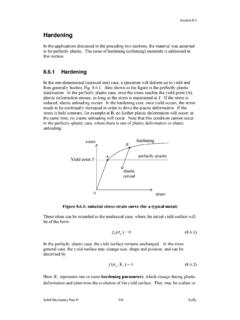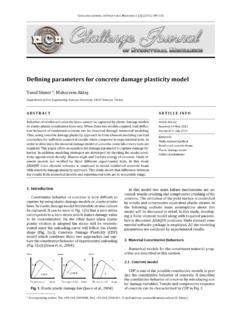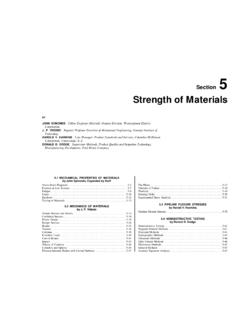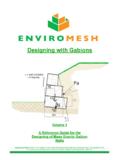Transcription of Description and classification of soils and rocks
1 1 Chapter 2 Description and classification of soils and rocks INTRODUCTION From an engineering viewpoint, the ground beneath a site can conveniently be divided into the categories shown in Table , which are based upon generalizations of its expected behaviour in construction works. These broad generalizations are, of course, limited in accuracy. But they give the geotechnical engineer a good basis on which to consider, at the start of a project, both the likely construction problems and the methods of investigation which might be used. In practice, it is found that the ground varies continuously beneath a site, and it is not often possible to find sharp transitions from one type of material to another. This then, calls for more refined, systematic, Description and classification of soils and rocks . The history of soil classification and Description has been described by Child (1986).
2 Early attempts to divide soil into different categories used laboratory testing, typically particle size distribution. Casagrande (1947) considered that much of this textural soil classification was unreliable, because it did not always reflect the effects of silt and clay on the engineering behaviour of the mass. On the basis of his experience he considered that only the Airfield classification System, which was based on the results of particle size analysis and plasticity (Atterberg limit) tests (see Chapter 8), was suitable for an assessment of soil for airfield pavement design. It was noted that, with experience, soil might be classified on the basis of visual/manual Description alone; Casagrande therefore suggested what he termed descriptive soil classification . American practice therefore developed in two directions.
3 soil classification , based on Casagrande s Airfield classification System, became standardized (ASTM D2487 92). As originally proposed, the system is based solely on particle size distribution and plasticity tests, and soils are designated by letters alone, depending upon which group they fall into. At the same time, a soil Description system has been developed, based upon visual examination and simple land tests (ASTM D2488 69). Table Categories of ground beneath a site Material type Strength Compressibility Permeability Rock Very high Very low Medium to high Granular soil High Low High Cohesive soil Low High Very low Organic soil Very low Very high High Made ground Medium to very low Medium to very high Low to high Early British practice was summarized in Cooling et al. s discussion of Casagrande s 1947 paper. Almost without change, this appeared in the first British Code of Practice on Site Investigations, Code of Practice No.
4 1 (1950). It was republished as Table 1 of CP 2001:1957. soil Description was based on estimated mass engineering behaviour, and used simple visual Description and hand tests. A classification system based on Casagrande s work was included for roads and airfields work, that is to assess the behaviour of materials during compaction and under pavements. Subsequent development Description and classification of soils and rocks 2occurred primarily through work by Akroyd (1957), Dumbleton (1968, 1981), Dumbleton and Nixon (1973), and the Engineering Group Working Party on The Preparation of Maps and Plans in Terms of Engineering Geology (Geological Society of London 1972). BS 5930:1981 contained two parts, a soil Description based on mass behaviour, and the British soil classification System (BSCS) based on the work of Dumbleton (1968, 1981). soil AND ROCK Description soil and rock Description is to a certain degree subjective.
5 In order to minimise the subjective element a systematic examination should be carried out using a standard terminology, whether the material be in a natural exposure, trial pit face or samples recovered from a borehole. The use of a standardised scheme of Description ensures that: (i) all factors are considered and examined in logical sequence (ii) no essential information is omitted (iii) no matter who describes the sample, the same basic Description is given using all terms in an identical way (iv) the Description conveys an accurate mental image to the readers (v) any potential user can quickly extract the relevant information. Norbury et al., 1986 The engineering Description of the ground conditions beneath a site is a progressive exercise which at each step involves further departure from strictly factual Description , and thus an increased interpretative element.
6 Three steps are involved. 1. The Description of individual samples from a borehole, each sample being described in isolation and in completely factual terms, noting any disturbance or obvious loss of material caused by sampling. Any two geologists or engineers with sufficient and comparable experience should produce almost identical descriptions . 2. The combination of these individual descriptions to form a stratum Description on the borehole log. In so doing, the engineer or geologist will take into account the information on the ground conditions, depths to strata changes, groundwater levels, field and laboratory test results, etc., given on the driller s daily record sheets. Interpretation is necessary, and so, as Norbury et al. have stated strictly, there is no such thing as a factual borehole log . 3.
7 The drawing together of individual borehole, trial pit and exposure records, to arrive at an assessment of the mass properties of the various strata, their geometric distribution, and their variability, in a summary in the text of the ground investigation report. In this process the skills of soil and rock Description , coupled with experience, are paramount. soil Description The Description of soil is currently covered, in the UK, by BS 5930:1981. At the time of writing BS 5930 is under revision. The system of soil Description given below therefore does not follow completely the code, but takes into account both current good practice, and changes which have been proposed. Samples must be described in a routine way, with each element of the Description having a fixed position within the overall Description : a) consistency or relative density; b) fabric or fissuring; Site Investigation 3c) colour; d) subsidiary constituents; e) angularity or grading of principal soil type; f) PRINCIPAL soil TYPE (in capitals); g) more detailed comments on constituents or fabric; h) (geological origin, if known) (in brackets); and i) soil classification symbols (optional).
8 descriptions should be simple, since very detailed comments on all aspects of a soil lead to confusion. Some examples are given below: Very stiff fissured dark grey CLAY (London clay) (a) (b) (c) (f) (h) Loose brown very sandy subangular coarse GRAVEL with pockets of soft grey clay (a) (c) (d) (e) (f) (g) Firm laminated brown SILT and CLAY (a) (b) (c) (f) (f) soil types In routine soil Description , the material being considered is first placed into one of the principal soil types in Table Table Principal soil types soil type Description CLAY BOULDERS COBBLES GRAVEL SAND SILT PEAT MADE GROUND Cohesive soil Granular soils Granular soils Granular soils Granular soils Granular soils Organic soil Man-made soils and other materials Most soils will be composed of a variety of different particle sizes, some of which may be cohesive.
9 Whilst classification is concerned only to determine the proportion by weight of each constituent, Description is carried out to ascertain probable engineering behaviour. In this sense, we adhere to the proposals of CP 2001 (1957) and reject BS 5930:1981, following Norbury et al. (1986) (Table ). Table Comparison of CP 2001 and BS 5930 CP 2001 BS 5930 soils possessing cohesion and plasticity are described as fine soils , although the majority of the soil by weight may be coarse or very coarse soil . It is not possible to give a percentage of clay and/or silt above which they become the principal component, since the mass behaviour depends on the mineralogy of the soil particles. The Description is based on engineering judgement. soils with more than 35% clay and/or silt are described as either clay or silt. soils with less than 35% are described in terms of coarse or very coarse soils , irrespective of whether they have cohesion and plasticity.
10 The Description is therefore based on the particle size distribution, but the division between silt and clay is strictly on the Atterberg limits. These factors can be difficult to assess visually for some materials and laboratory tests are required to confirm descriptions . Description and classification of soils and rocks 4 The fundamental difference between these two proposals is that under the BS 5930:1981 proposals, many clays materials of low strength, very low permeability and high compressibility, must be termed silts, sands or gravels. In practice the addition of about only 12% by weight of clay is required to make a well-graded granular material perform in engineering works as a cohesive soil . Therefore the stance of BS 5930:1981 is considered untenable. The first stage of the Description process is the identification of the principal soil type, on the basis of the expected behaviour of the soil mass.









